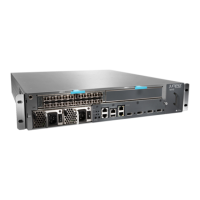The T1600 router can operate with any combination of FPC1s, FPC2s, FPC3s, and FPC4s
installed. Each FPC contains one or two Packet Forwarding Engines. The Packet
Forwarding Engine consists of Layer 2/Layer 3 Packet Processing application-specific
integrated circuits (ASICs), Switch Interface ASICs, T Series Internet Processor ASICs,
and a memory subsystem (MMB) which includes the Queuing and Memory Interface
ASICs. The Packet Forwarding Engine receives incoming packets from the PICs installed
on the FPC and forwards them through the switch planes to the appropriate destination
port. Each FPC contains data memory, which is managed by the Queuing and Memory
Interface ASICs. Each FPC3 and each T1600 FPC4 has two Packet Forwarding Engines,
and each FPC2 and each T640 FPC3 has one Packet Forwarding Engine.
PICs provide the physical connection to various network media types, receiving incoming
packets from the network and transmitting outgoing packets to the network. PICs for
the T1600 router currently support the following network media types: Gigabit Ethernet,
SONET/SDH OC12c/STM4, OC48c/STM16, OC192c/STM64, and OC768c/STM256. The
router also supports MultiServices PICs and Tunnel Service PICs. You can install up to
four PICs into the slots in each FPC. For more information on PICs used in the router, see
the T1600 Core Router PIC Guide.
The Switch Interface Boards (SIBs) provide the switching function to the destination
FPC. The SIBs create the switch fabric for the router, providing up to a total of 1.92 billion
Mpps of forwarding. Five SIBs are installed in the router.
The host subsystem provides the routing and system management functions of the
router. The host subsystem consists of the Routing Engine and the Control Board. The
Routing Engine maintains the routing tables used by the router and controls the routing
protocols that run on the router.
Each Control Board works with an adjacent Routing Engine to provide control and
monitoring functions for the router. These functions include determining Routing Engine
mastership; controlling power, reset, and SONET clocking for the other router components;
monitoring and controlling fan speed; and monitoring system status using I²C controllers.
ASICs are a definitive part of the router design; these ASICs enable the router to achieve
data rates that match current fiber-optic capacity.
Related
Documentation
T1600 Router Major Hardware Components on page 37•
T1600 Router Major Hardware Components
Table 14 on page 38, lists the major T1600 router components and their characteristics.
37Copyright © 2012, Juniper Networks, Inc.
Chapter 2: T Series Core Routers

